牛津译林高一知识点总汇(英语)
(完整word版)高一英语单词重点牛津译林版
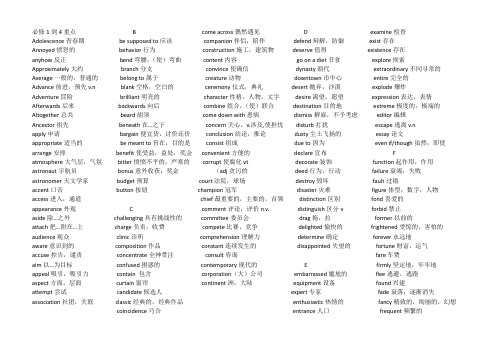
必修1到4重点 B come across偶然遇见 D examine检查Adolescence青春期be supposed to应该companion伴侣,陪伴defend辩解,防御exist存在Annoyed愤怒的behavior行为construction施工,建筑物deserve值得existence存在anyhow反正bend弯腰,(使)弯曲content内容go on a diet节食explore探索Approximately大约branch分支convince使确信dynasty朝代extraordinary不同寻常的Average一般的,普通的belong to属于creature动物downtown市中心entire完全的Advance前进,预先v.n blank空格,空白的ceremony仪式,典礼desert抛弃,沙漠explode爆炸Adventure冒险brilliant明亮的character性格,人物,文字desire渴望,愿望expression表达,表情Afterwards后来backwards向后combine组合,(使)联合destination目的地extreme极度的,极端的Altogether总共beard胡须come down with患病dismiss解雇,不予考虑editor编辑Ancestor祖先beneath在…之下concern关心,v.涉及,使担忧disturb打扰escape逃离v.napply申请bargain便宜货,讨价还价conclusion结论,推论dusty尘土飞扬的essay论文appropriate适当的be meant to旨在,目的是consist组成due to因为even if/though虽然,即使arrange安排benefit使受益,益处,奖金convenient方便的declare宣布 Fatmosphere大气层,气氛bitter愤愤不平的,严寒的corrupt使腐化vt decorate装饰function起作用,作用astronaut宇航员bonus意外收获,奖金(adj贪污的deed行为,行动failure衰竭,失败astronomer天文学家budget预算court法院,球场destroy毁坏fault过错accent口音button按钮champion冠军disaster灾难figure体型,数字,人物access进入,通道chief最重要的,主要的,首领distinction区别fond喜爱的appearance外观 C comment评论,评价n.v. distinguish区分v forbid禁止aside除…之外challenging具有挑战性的committee委员会drag拖,拉former以前的attach把…附在…上charge负责,收费compete比赛,竞争delighted愉快的frightened受惊的,害怕的audience观众clinic诊所comprehension理解力determine确定forever永远地aware意识到的composition作品constant连续发生的disappointed失望的fortune财富,运气accuse控告,谴责concentrate全神贯注consult咨询fare车费aim以…为目标confused困惑的contemporary现代的 E firmly坚定地,牢牢地appeal吸引,吸引力contain 包含corporation(大)公司embarrassed尴尬的flee逃避,逃跑aspect方面,层面curtain窗帘continent洲,大陆equipment设备found兴建attempt尝试candidate候选人expert专家fade衰落,逐渐消失association社团,关联classic经典的,经典作品enthusiastic热情的fancy精致的,绚丽的,幻想coincidence巧合entrance人口frequent频繁的Generation一代,一代人kindness善意movement社会活动,移动poison毒药,下毒somehow不知为何Get into shape强生健体kettle壶multiply成倍增加,乘pour倒出,倾泻splendid极好的Guidance指导L N practical切实可行的,实用的starve挨饿,使挨饿Glance瞥一眼limit限制now that既然,由于process过程schedule计划n.vGlory荣耀,辉煌literary文学的nationality国籍puzzle迷,疑问shade阴凉处Gradually渐渐地look back (on)回忆native本国的,本地的passive被动的statement陈述Grasp抓紧labour劳动narrow狭窄的persuade说服status地位,身份Grateful感激的link联系nearby在附近(的)poisonous有毒的steep陡峭的,急剧的Get something across look into调查nowadays现在precious宝贵的supply提供把..表达清楚look up to敬佩nowhere无处presentation展示,介绍,提交surrounding周围的Grain谷物lecture讲座nation国家promote推广servant仆人Grocery杂货店loose松动的,松开nationwide全国范围的purchase购买n.v simplify简化H liquid液体(的)nephew侄子R stare盯着看Hairy毛茸茸的lung肺O recover恢复,复原secure安全的,稳固的Harmony和谐outing短途旅行rare稀有的significance重要性Heaven天堂M overweight体重超标的reflect反射,反映slave奴隶Harbor港口midnight午夜occur发生riddle迷THesitate犹豫misunderstand误解optimistic乐观的rough粗糙的,汹涌的,大概的tend往往,趋向Hang on坚持mostly主要地,通常observe观察,评论raised凸起的tolerate允许I mild平和的,温暖的occupy占领,占用relief轻松,宽慰therefore因此In the long term从长远角度看mainland大陆ought to应该remains遗物,遗迹target目标,瞄准Incident发生的事情march前进opening开幕式,小孔replace替换technique技术,工艺Indeed的确adv material材料,物质的operator操作人员react反应UInspire激励,启迪memorial纪念碑(馆),纪念的origin起源recipe烹饪法,食谱unique独特的Ignore忽视mist水汽,薄雾P referee裁判update更新Indicate显示make way for给…让路properly适当的remove开除,移开urban城市的Institute机构,研究所mankind人类preserve保持,保存routine常规(的)urge敦促Interrupt打断,暂停meanwhile与此同时panic惊慌,恐慌S V various各种各样的Impression印象medal奖牌pattern图案,方式scene场面,景色vast辽阔的Innocent清白的mental心理的,智力的pavement人行道select选择,挑选W wander漫游widespread广泛的Intelligence智力motto座右铭,格言phrase词组,短语selfish自私的welfare幸福,福利worn破旧的。
(完整word版)高一英语单词重点牛津译林版.doc
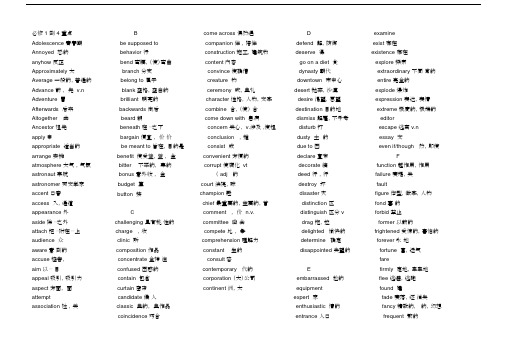
必修 1 到 4 重点 B come across 偶然遇 D examineAdolescence 青春期be supposed to companion 伴,陪伴defend 解,防御exist 存在Annoyed 怒的behavior 行construction 施工,建筑物deserve 得existence 存在anyhow 反正bend 弯腰,(使)弯曲content 内容go on a diet 食explore 探索Approximately 大branch 分支convince 使确信dynasty 朝代extraordinary 不同常的Average 一般的,普通的belong to 属于creature 物downtown 市中心entire 完全的Advance 前,先 v.n blank 空格,空白的ceremony 式,典礼desert 抛弃,沙漠explode 爆炸Adventure 冒brilliant 明亮的character 性格,人物,文字desire 渴望,愿望expression 表达,表情Afterwards 后来backwards 向后combine 合,(使)合destination 目的地extreme 极度的,极端的Altogether 共beard 胡come down with 患病dismiss 解雇,不予考editorAncestor 祖先beneath 在⋯之下concern 关心, v.涉及 ,使担disturb 打escape 逃离 v.napply 申bargain 便宜,价价conclusion ,推dusty 土的essay 文appropriate 适当的be meant to 旨在,目的是consist 成due to 因even if/though 然,即使arrange 安排benefit 使受益,益,金convenient 方便的declare 宣布 Fatmosphere 大气,气氛bitter 不平的,寒的corrupt 使腐化 vt decorate 装function 起作用,作用astronaut 宇航bonus 意外收,金( adj 的deed 行,行failure 衰竭,失astronomer 天文学家budget 算court 法院,球destroy 坏faultaccent 口音button 按champion 冠disaster 灾figure 体型,数字,人物access 入,通道chief 最重要的,主要的,首distinction 区fond 喜的appearance 外 C comment ,价 n.v. distinguish 区分 v forbid 禁止aside 除⋯之外challenging 具有挑性的committee 委会drag 拖,拉former 以前的attach 把⋯附在⋯上charge ,收compete 比,争delighted 愉快的frightened 受惊的,害怕的audience 众clinic 所comprehension 理解力determine 确定forever 永地aware 意到的composition 作品constant 生的disappointed 失望的fortune 富,运气accuse 控告,concentrate 全神注consult 咨fareaim 以⋯目confused 困惑的contemporary 代的 E firmly 定地,牢牢地appeal 吸引,吸引力contain 包含corporation (大)公司embarrassed 尬的flee 逃避,逃跑aspect 方面,面curtain 窗帘continent 洲,大equipment found 建attempt candidate 候人expert 家fade 衰落,逐消失association 社,关classic 典的,典作品enthusiastic 情的fancy 精致的,的,幻想coincidence 巧合entrance 人口frequent 繁的Generation 一代,一代人Get into shape 生健体Guidance 指Glance 瞥一眼Glory 荣耀,煌Gradually 地Grasp 抓Grateful 感激的Get something across把 ..表达清楚Grain 谷物Grocery 店HHairy 毛茸茸的Harmony 和Heaven 天堂Harbor 港口Hesitate 犹豫Hang on 持IIn the long term 从角度看Incident 生的事情Indeed 的确 advInspire 激励,启迪Ignore 忽Indicate 示Institute 机构,研究所Interrupt 打断,停Impression 印象Innocent 清白的Intelligence 智力kindness 善意movement 社会活,移kettle multiply 成倍增加,乘L Nlimit 限制now that 既然,由于literary 文学的nationality 国籍look back (on) 回native 本国的,本地的labour narrow 狭窄的link 系nearby 在附近(的)look into nowadays 在look up to 敬佩nowhere 无lecture 座nation 国家loose 松的,松开nationwide 全国范的liquid 液体(的)nephew 侄子lung 肺Oouting 短途旅行M overweight 体重超的midnight 午夜occur 生misunderstand 解optimistic 的mostly 主要地,通常observe 察,mild 平和的,温暖的occupy 占,占用mainland 大ought tomarch 前opening 开幕式,小孔material 材料,物的operator 操作人memorial 念碑(),念的origin 起源mist 水汽,薄Pmake way for ⋯ 路properly 适当的mankind 人preserve 保持,保存meanwhile 与此同panic 惊慌,恐慌medal 牌pattern 案,方式mental 心理的,智力的pavement 人行道motto 座右,格言phrase ,短poison 毒,下毒pour 倒出,泻practical 切可行的,用的process 程puzzle 迷,疑passive 被的persuade 服poisonous 有毒的precious 宝的presentation 展示,介,提交promote 推广purchase n.vRrecover 恢复,复原rare 稀有的reflect 反射,反映riddle 迷rough 粗糙的,汹涌的,大概的raised 凸起的relief 松,慰remains 物,迹replace 替react 反recipe 烹法,食referee 裁判remove 开除,移开routine 常(的)Sscene 面,景色select ,挑selfish 自私的somehow 不知何splendid 极好的starve 挨,使挨schedule 划 n.vshade 阴凉statement 述status 地位,身份steep 陡峭的,急的supply 提供surrounding 周的servant 仆人simplify 化stare 着看secure 安全的,固的significance 重要性slave 奴隶Ttend 往往,向tolerate 允therefore 因此target 目,瞄准technique 技,工Uunique 独特的update 更新urban 城市的urge 敦促V various 各种各的vast 的W wander 漫游 widespread 广泛的welfare 幸福,福利 worn 破旧的。
译林牛津高一英语M1重点短语和句子

Unit One School life一、重点短语1. be experienced in…做某事有经验 1. earn (one’s) respect 赢得(某人的)尊敬2. earn one’s living by ---靠---谋生3. show respect for sb.向某人表示尊重4. respect sb. for sth.因…而尊重某人5. out of respect 出于尊重6. devote oneself /one’ life / time/ energy to (doing)sth.…=be devoted to to (doing)sth.…致力于…;献身于…7. on average 平均(起来)8. above/ below (the) average高/低于平均水平9. an average student 一个普通学生a top student 一个尖子生 10. struggle for…为…而奋斗/努力 11. struggle to do sth.努力/奋力做某事 12. be fond of 喜爱,喜欢 13. face a challenge 面临挑战 14. accept a/the challenge 接受挑战 15. encourage sb. to do 鼓励某人做某事 16. for free = free of charge 免费17. ★be free from…免遭…; 免受…; 没有… 18. set…free 释放… 19. look back on…回顾,回忆 20. look down upon/ on…看不起21. look forward to…盼望,期望 22. look into…调查23. look out = watch out=take care 当心,小心 24. look up a word in the dictionary=refer to/consult the dictionary 查字典 25. look up to sb. = respect sb.尊敬某人26. be/ feel satisfied with…对…感到满意27. satisfy sb. = make sb. satisfied 使某人满意 28. to one’s satisfaction 令人满意的是 29. much to one’s satisfaction=to one’s greatsatisfaction 使某人很满意的是 30. with satisfaction 满意地31. exchange opinions/ views 交换观点 32. in exchange for…作为…的交换 33. exchange A for B 把A 换成B34. the former…; the latter…前者…;后者… 35. graduate from…毕业于…36. on/ upon graduation= on/ upon graduating(from---)一毕业就…37. donate… to…=make a donation to…把…捐赠给38. be independent of…独立于…;不依赖… 39. depend on/upon=be dependent on/ upon依靠/依赖…;取决于…40. develop an interest in…培养某方面的兴趣41. with the development of…随着…的发展 42. make use of= take advantage of……利用 43. make good use of…好好利用44. make full use of…= make the best of…= make the most of…充分利用 45. be of great use= be very useful 很有用46. It is no use doing…= It is useless doing…做某事是没用的47. in charge of…负责,掌管(介词短语)48. take charge of…掌管,负责(动词短语) 49. in the charge of…在…的掌管之下 50. charge sb. with…指控某人(做)某事 51. charge sb. some money 向某人收费 52. more than + n. 不仅仅是53. more than +adj. 非常…more than happy 54. achieve one’s goals 实现某人的目标 55. achieve success 获得成功56. inform sb. of/ about…通知/告知某人某事 57. keep sb. informed of…随时通知某人某事 58. run a club 管理一家俱乐部 59. run into…= come across 偶然遇见 60. during the lunch break 午饭休息时间61. (sth.) run out (某物)用完62. run out of sth. 用完(某物)63. approve of sb/sb’s doing 同意某人做某事64. in preparation 在准备中65. make preparations for= prepare for……为…做准备(表动作)66. be prepared for…为…做好准备(表状态) 67. select sb. as…选拔某人作为… 68. regret doing 后悔做了某事69. regret to do 对将做得事情表示遗憾, 如:regret to say/ tell/ inform…70. generation gap 代沟 71. require sb. to do sth.要求某人做某事 72. require that---(should)do 要求---做某事73. sign up ( for) 签约74. be available for/have access to---可获得--- 二、句子1. Going to a British high school for one year was a very enjoyable and exciting experiencefor me. 在英国上了一年的中学对我来说是一段非常令人愉快和兴奋的经历。
牛津译林版高中英语必修一知识

牛津译林版高中英语必修一知识本文档旨在介绍牛津译林版高中英语必修一的知识内容。
以下是该教材的主要内容概述:Unit 1 Friendship在这个单元中,学生将研究到有效的沟通技巧,并了解到良好的沟通对友谊的重要性。
通过角色扮演和小组合作活动,学生将提高他们的口语和听力技能。
1.2 Friendship Traits学生将研究友谊的特质和价值观,并探讨真正的友谊是如何建立的。
通过阅读和讨论文章,学生将加深对友谊的理解,并研究如何培养和维护友谊。
Unit 2 Cultural Relics2.1 Historical Relics在这个单元中,学生将了解到一些世界上最重要的历史文物,并研究到如何保护和传承人类文明的重要财富。
通过阅读和写作活动,学生将提高他们的阅读和写作能力,并增加他们对历史文化的认识。
2.2 Cultural Heritage学生将研究一些国际上重要的文化遗产,并了解到它们对于世界文化多样性的重要性。
通过小组讨论和展示活动,学生将提高他们的口语和表达能力,同时深入了解各个文化遗产的独特之处。
Unit 3 Music3.1 Music Genres学生将了解不同类型的音乐,并研究到音乐对人们情绪和心理的影响。
通过听歌曲、讨论和写作活动,学生将增加对音乐的鉴赏能力,并探索不同类型音乐背后的文化和情感。
3.2 Music Legends学生将研究一些音乐传奇人物的故事,并了解他们为音乐界做出的重要贡献。
通过阅读和听力练,学生将提高他们对音乐历史和音乐人生涯的了解,并增加他们对音乐文化的欣赏。
以上是牛津译林版高中英语必修一的知识内容概述。
这些内容将帮助学生提高他们的英语技能,并拓宽他们的文化视野。
译林牛津版高中英语专题总复习:高一重点词汇二.知识讲解

高考总复习:必修一词汇2Units4-5单词部分:burst【点拨】vi.vt.使某物爆炸,胀破,爆破,破裂burst in/into a room/building突然进入房间/大楼burst into sth.=burst out doing突然…起来He burst into the room without knocking at the door.他没有敲门就突然进入房间。
The plane crashed and burst into flames.飞机坠毁起火了。
All of them burst out laughing/crying/singing.=All of them burst into laughter/tears/songs.他们全都突然笑起来/哭起来/唱起来.【拓展】be bursting to do sth急于要做某事He was bursting to tell her the news.他急于要告诉她这条消息。
burst forth突然出现,突然爆发出,突然喊出A broad smile burst forth on his face.他顿时笑容满面。
“Why don’t you behave?”he burst forth.“你为什么不放规矩一点呢?”他大声喊。
burst into突然闯入;突然……起来,后通常接具有动作意义的名词。
When I handed him the gift card,saying he could rise it for whatever his family might need,he burst into tears.(2015高考新课标I)当我把礼品卡交给他时,说他可以用它买家庭有可能所需要的任何东西,他突然哭了。
The entire hall burst into thunder ous cheers.全场发出了雷鸣般的欢呼。
高一知识清单译林牛津版 Module 1 Unit 2 Growing pains

Module 1 Unit 2 Growing painsWelcome & Reading一、重点短语1. grow up 长大成人;成长2. turn up 出现,开大音量3. be home 到家4. a waste of time 浪费时间5. earlier than expected 比预料的早6. can’t wait to do sth 迫不及待做某事7. be supposed to 应当做某事8. followed by 后面跟着9. be gone 不见;消失;丢失10. all over 遍及11. in a mess 乱七八糟12. be on vacation 在度假13. in the corner 在角落里14. a garbage can 垃圾箱15. pieces of 一片片的16. in charge (of)负责17. act like 充当;当任18. make decisions做决定19. tolerate such behavior容忍如此行为20. shout at向…吆喝21. as lights go out 当灯光熄灭时22. give sb a chance给某人机会23. have an emergency 遇有紧急情况24. deserve an explanation值得解释25. take sb to the clinic 带某人就医26. have no time to do没时间做27. be too hard on sb对某人太苛刻28. be rude to sb对某人粗鲁二、重点句型1. We thought you could act like an adult, but look at the mess!2. Daniel has his arms crossed and looks upset.3. The money for dog food is gone, but Spot looks like he is starving.4. Maybe, but now that he has been so rude to us, I feel like we have to punish him or he won’t respect us.5. We won’t tolerate such behavior in our house.6. There is probably a good explanation for everything, but you are not supposed to act that way.7. Daniel has his arms crossed and looks upset.8.Anyhow, next time we were on vacation, if you have an emergency like this you should call us.Word power, grammar & task一、重点短语1. differ in many ways 在很多方面不同2. shopping centre购物中心3. a piece of cake 小菜一碟4. a wet blanket扫兴的人或物5. make friends with与某人交朋友6. in the past在过去7. go to the cinema去看电影8. go to sleep入睡9. make sb upset使某人不安10. a little bit expensive稍微有点贵11.be nervous about对…感到紧张12. make an error出差错13. insist on doing坚持做某事14. get along with相处;进展15. get annoyed 生气的16. all ears 全神贯注地听17. pull one’s leg开玩笑18.have green fingers 绿手指;园艺能手19. the top dog 胜利者;主要人物20. give sb the cold shoulder冷眼相待21. rain cats and dogs下倾盆大雨22one’s cap of tea某人钟爱之物二、重点句型1. However , I am worried that if I keep allowing him to do what he want he wants, he may fail at school, or worse.2. The way (that/ in which) he teaches English is interesting.3. Dad is a person whom /that /who I can easily talk to.4. The study is the place where/ in which I often have talks with my father.5. He even forbids me from chatting with my friends in the Internet café! Project一、重点短语1. feel lonely感觉寂寞2. in other ways在别的方面3. out of control失去控制4. go through经历;经受5. become confused with对…感到困惑6. psychological changes心理变化7. in this regard在这一方面8. part of the group群体的一部分9. fit in society适应社会10. be traded for与…交易二、重点句型1.. This feelings are a common part of adolescence——the time of lifebetween child and adult.2. These feelings can be thought of as growing pains——the difficulties thatteenagers face as they grow to adults.3. At the same time, girls often want someone——anyone——to talk to,, asthey try to deel with their strong feelings.4. In the social world, as teenagers get older, they struggle to depend on themselves.5. The good news is that these kinds of growing pains do not last.。
牛津译林版高一英语上册必修一Unit1知识要点总结
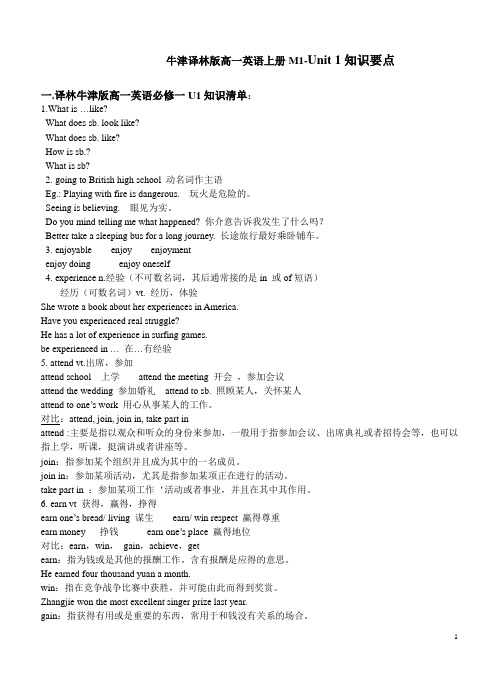
牛津译林版高一英语上册M1-Unit 1知识要点一.译林牛津版高一英语必修一U1知识清单:1.What is …like?What does sb. look like?What does sb. like?How is sb.?What is sb?2. going to British high school 动名词作主语Eg.: Playing with fire is dangerous. 玩火是危险的。
Seeing is believing. 眼见为实。
Do you mind telling me what happened? 你介意告诉我发生了什么吗?Better take a sleeping bus for a long journey. 长途旅行最好乘卧铺车。
3. enjoyable enjoy enjoymentenjoy doing enjoy oneself4. experience n.经验(不可数名词,其后通常接的是in 或of短语)经历(可数名词)vt. 经历,体验She wrote a book about her experiences in America.Have you experienced real struggle?He has a lot of experience in surfing games.be experienced in …在…有经验5. attend vt.出席,参加attend school 上学attend the meeting 开会,参加会议attend the wedding 参加婚礼attend to sb. 照顾某人,关怀某人attend to one’s work 用心从事某人的工作。
对比:attend, join, join in, take part inattend :主要是指以观众和听众的身份来参加,一般用于指参加会议、出席典礼或者招待会等,也可以指上学,听课,挺演讲或者讲座等。
牛津译林版高一英语上册必修一 语法总结
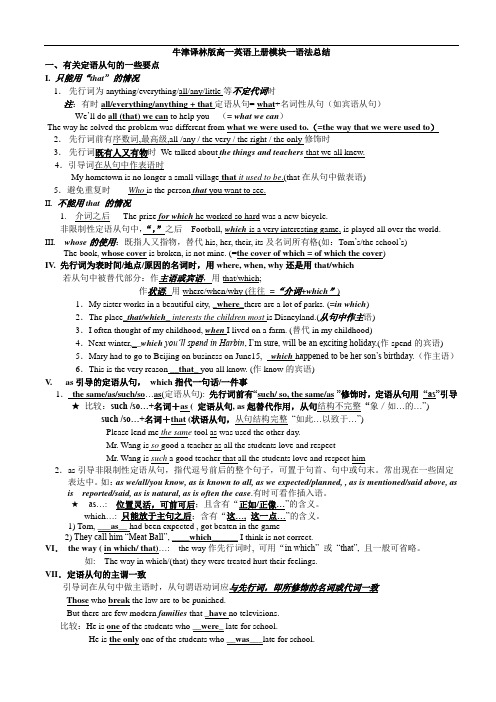
牛津译林版高一英语上册模块一语法总结一、有关定语从句的一些要点I. 只能用“that”的情况1.先行词为anything/everything/all/any/little等不定代词时注:有时all/everything/anything + that定语从句= what+名词性从句(如宾语从句)We’ll do all (that) we can to help you (= what we can)The way he solved the problem was different from what we were used to.(=the way that we were used to)2.先行词前有序数词,最高级,all /any / the very / the right / the only修饰时3.先行词既有人又有物时We talked about the things and teachers that we all knew.4.引导词在从句中作表语时My hometown is no longer a small village that it used to be.(that在从句中做表语)5.避免重复时Who is the person that you want to see.II. 不能用that 的情况1.介词之后The prize for which he worked so hard was a new bicycle.非限制性定语从句中,“,”之后Football,which is a very interesting game, is played all over the world. III. whose的使用:既指人又指物,替代his, her, their, its及名词所有格(如:Tom’s/the school’s) The book, whose cover is broken, is not mine. (=the cover of which = of which the cover)IV. 先行词为表时间/地点/原因的名词时,用where, when, why还是用that/which若从句中被替代部分:作主语或宾语,用that/which;作状语, 用where/when/why (往往=“介词+which”)1.My sister works in a beautiful city, _where_there are a lot of parks. (=in which)2.The place_that/which_ interests the children most is Disneyland.(从句中作主语)3.I often thought of my childhood, when I lived on a farm. (替代in my childhood)4.Next winter,__which you’ll spend in Harbin, I’m sure, will be an exciting holiday.(作spend的宾语)5.Mary had to go to Beijing on business on June15, which h appened to be her son’s birthday.(作主语)6.This is the very reason __that_ you all know. (作know的宾语)V. as引导的定语从句,which指代一句话/一件事1.the same/as/such/so…as(定语从句):先行词前有“such/ so, the same/as ”修饰时,定语从句用“as”引导★比较:such /so…+名词+as ( 定语从句, as起替代作用,从句结构不完整“象/如…的…”) such /so…+名词+that (状语从句,从句结构完整“如此…以致于…”)Please lend me the same tool as was used the other day.Mr. Wang is so good a teacher as all the students love and respectMr. Wang is such a good teacher that all the students love and respect him 2.as引导非限制性定语从句,指代逗号前后的整个句子,可置于句首、句中或句末。
译林版高中英语词汇汇总(必修第一册)
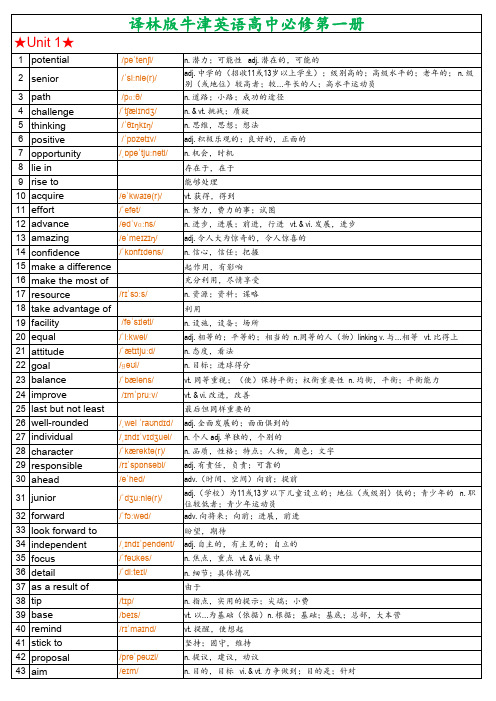
1potential/pəˈtenʃl/n. 潜力;可能性 adj. 潜在的,可能的2senior/ˈsi ːniə(r)/adj. 中学的(招收11或13岁以上学生);级别高的;高级水平的;老年的; n. 级别(或地位)较高者;较…年长的人;高水平运动员3path/p ɑːθ/n. 道路;小路;成功的途径 4challenge/ˈtʃælɪndʒ/ n. & vt. 挑战;质疑 5thinking/ˈθɪŋkɪŋ/ n. 思维,思想;想法 6positive/ˈpɒzətɪv/ adj. 积极乐观的;良好的,正面的7opportunity/ˌɒpəˈtju ːnəti/ n. 机会,时机8lie in存在于,在于9rise to能够处理10acquire/əˈkwaɪə(r)/ vt. 获得,得到 11effort/ˈefət/ n. 努力,费力的事;试图 12advance/ədˈv ɑːns/ n. 进步,进展;前进,行进 vt. & vi. 发展,进步 13amazing/əˈmeɪzɪŋ/ adj. 令人大为惊奇的,令人惊喜的14confidence/ˈkɒnfɪdəns/ n. 信心,信任;把握15make a difference起作用,有影响16make the most of充分利用,尽情享受 17resource/rɪˈsɔːs/ n. 资源;资料;谋略 18take advantage of利用 19facility/fəˈsɪləti/n. 设施,设备;场所 20equal/ˈi ːkwəl/ adj. 相等的;平等的;相当的 n.同等的人(物)linking v. 与…相等 vt. 比得上21attitude/ˈætɪtju ːd/ n. 态度,看法 22goal/ɡəʊl/ n. 目标;进球得分23balance/ˈbæləns/vt. 同等重视;(使)保持平衡;权衡重要性 n. 均衡,平衡;平衡能力 24improve/ɪmˈpru ːv/ vt. & vi. 改进,改善 25last but not least最后但同样重要的 26well-rounded/ˌwel ˈraʊndɪd/ adj. 全面发展的;面面俱到的27individual/ˌɪndɪˈvɪdʒuəl/ n. 个人 adj. 单独的,个别的28character/ˈkærəktə(r)/ n. 品质,性格;特点;人物,角色;文字29responsible/rɪˈspɒnsəbl/ adj. 有责任,负责;可靠的30ahead/əˈhed/ adv.(时间、空间)向前;提前31junior/ˈdʒu ːniə(r)/ adj.(学校)为11或13岁以下儿童设立的;地位(或级别)低的;青少年的 n. 职位较低者;青少年运动员32forward/ˈfɔːwəd/ adv. 向将来;向前;进展,前进33look forward to盼望,期待34independent/ˌɪndɪˈpendənt/ adj. 自主的,有主见的;自立的35focus/ˈfəʊkəs/ n. 焦点,重点 vt. & vi. 集中36detail/ˈdi ːteɪl/ n. 细节;具体情况37as a result of由于38tip/tɪp/ n. 指点,实用的提示;尖端;小费39base/beɪs/ vt. 以…为基础(依据)n. 根据;基础;基底;总部,大本营 40remind/rɪˈmaɪnd/ vt. 提醒,使想起 41stick to坚持;固守,维持 42proposal/prəˈpəʊzl/ n. 提议,建议,动议 43aim /eɪm/ n. 目的,目标 vi. & vt. 力争做到;目的是;针对★Unit 1★译林版牛津英语高中必修第一册44style /staɪl/ n. 风格;方式;样式45technique /tekˈniːk/ n. 技巧,技艺;技能46workshop /ˈwɜːkʃɒp/ n. 研讨会,讲习班;车间,作坊47professional /prəˈfeʃənl/ adj. 职业的,专业的;有职业的;娴熟的,精通业务的 n. 专门人员,专业人士48material /məˈtɪəriəl/ n. 材料;素材 adj. 物质的,实际的;客观存在的49poster /ˈpəʊstə(r)/ n. 海报;(在网络留言板上)发布消息的人50secondary /ˈsekəndri/ adj. 中学的;次要的51exchange /ɪksˈtʃeɪndʒ/ n. & vt. 交换;交流;兑换52host /həʊst/ n. 主人;东道主;主持人 vt. 主办;主持53 a.m. /ˌeɪ ˈem/ 上午,午前54p.m. /ˌpiː ˈem/ 下午,午后55biology /baɪˈɒlədʒi/ n. 生物学56tough /tʌf/ adj. 艰难的;严厉的;坚强的;坚固的57alarm /əˈlɑːm/ n. 闹钟;恐慌;警报;警报器 vt. 使惊恐,使害怕58contribution /ˌkɒntrɪˈbjuːʃn/ n. 贡献;捐款;捐赠59fortunately /ˈfɔːtʃənətli/ adv. 幸运地,幸亏60over time 随着时间流逝,久而久之61option /ˈɒpʃn/ n. 可选择的事物,选择;选修课62butter /ˈbʌtə(r)/ n. 黄油63pudding /ˈpʊdɪŋ/ n. 甜点;布丁64attract /əˈtrækt/ vt. 吸引,使喜爱;招引;引起(反应)65rugby /ˈrʌɡbi/ n. 橄榄球运动66calligraphy /kəˈlɪɡrəfi/ n. 书法,书法艺术★Unit 2★1nest /nest/ n. 鸟窝;巢穴,窝2roof /ruːf/ n. 屋顶,顶部3battle /ˈbætl/ n. & vt. & vi. 争论;战斗,搏斗;斗争4see eye to eye with sb (on sth)(在某事上)与某人看法一致5argument /ˈɑːɡjumənt/ n. 争吵,争论;论点6teenager /ˈtiːneɪdʒə(r)/ n. 青少年7tension /ˈtenʃn/ n. 紧张关系;紧张;拉伸8anxious /ˈæŋkʃəs/ adj. 忧虑的,担心的;令人焦虑的;渴望的9rate /reɪt/ n. 速度;率 vi. & vt. 评价,评估10shoot /ʃuːt/ vi. & vt. (shot, shot)(使朝某方向)冲,奔;射击;射杀;摄影11shoot up 快速长高,蹿个儿12spot /spɒt/ n. 粉刺;斑点;污渍;地点,场所13target /ˈtɑːɡɪt/ n. (攻击的)目标,对象;靶子vt. 把…作为攻击目标;面向14anger /ˈæŋɡə(r)/ n. 怒气,怒火15mental /ˈmentl/ adj. 思想的,精神的,智力的16adult /ˈædʌlt/ n. 成年人17desire /dɪˈzaɪə(r)/ n. & vt. 渴望,希望18struggle /ˈstrʌɡl/ vi. & n. 奋斗;斗争;搏斗19*rough /rʌf/ adj. 艰难的;粗糙的;不确切的20breakdown /ˈbreɪkdaʊn/ n.(关系)破裂;故障21regular /ˈreɡjələ(r)/ adj. 频繁的;有规律的22calm /kɑːm/ vt. 使平静,使镇静 adj. 镇静的,沉着的23calm down 平静,镇静,安静24view /vjuː/ n. 看法;视线;景色 vt. 把…视为;观看25from one’s point of view 从某人的角度、观点出发26think sth through 充分考虑,全盘考虑,想透27concern /kənˈsɜːn/ n. 担心,忧虑;关心 vt. 涉及;让(某人)担忧28back down 承认错误,认输29normal /ˈnɔːml/ adj. 正常的,一般的 n. 常态,通常标准30stress /stres/ n. 精神压力,紧张;强调 vt. 强调,着重31editor /ˈedɪtə(r)/ n. 主编,编辑;剪辑师32argue /ˈɑːɡjuː/ vi. 争吵,争辩,争论 vt. 说理,论证33skin /skɪn/ n. 皮肤;(兽)皮,毛皮34design /dɪˈzaɪn/ vt. 设计;制订 n. 设计;设计艺术35*forum /ˈfɔːrəm/ n. 论坛,讨论会;公共集会场所36expert /ˈekspɜːt/ n. 专家,行家 adj. 熟练的,内行的,专家的 /ˈekspɜːt/ n. 专家,行家 adj. 熟练的,内行的,专家的37likely /ˈlaɪkli/ adj. 可能的,预料的,有希望的38unique /juˈniːk/ adj. 独一无二的;独特的;独具的,特有的39passive /ˈpæsɪv/ adj. 消极的,被动的40performance /pəˈfɔːməns/ n. 表现;表演;执行,履行41cheer up(使)变得高兴,振奋起来42press /pres/ vt. & vi. 催促,逼迫;按,压;挤,推 n. 报章杂志,报刊;(the press)新闻工作者,新闻界43eager /ˈiːɡə(r)/ adj. 热切的,渴望的,渴求的44youth /juːθ/ n. 青年时期;青春;(the youth)年轻人45adventure /ədˈventʃə(r)/ n. 冒险,冒险经历,奇遇46be on sb’s back about sth缠磨,烦扰47kangaroo /ˌkæŋɡəˈruː/ n. 袋鼠48flexible /ˈfleksəbl/ adj. 灵活的,可变动的;柔韧的49account /əˈkaʊnt/ n. 账户;描述;解释 vt. 认为是,视为50rent /rent/ n. 租金 vi. & vt. 租用;出租51grocery /ˈɡrəʊsəri/ n. 食品杂货;食品杂货店52secure /sɪˈkjʊə(r)/ adj. 安心的;可靠的;牢固的53graduate /ˈɡrædʒueɪt/ vi. & vt. 毕业 /ˈɡrædʒuət/ n. 毕业生54gather /ˈɡæðə(r)/ vi. 聚集,集合 vt. 收拢;搜集,收集;聚集55emergency /iˈmɜːdʒənsi/ n. 突发事件,紧急情况56volunteer /ˌvɒlənˈtɪə(r)/ vt. & vi. 主动建议(或告诉);自愿做,义务做 n. 志愿者57pipe /paɪp/ n. 烟斗;管子;管乐器58figure /ˈfɪɡə(r)/ n. 数字;人物;体形,身材59downtown /ˌdaʊnˈtaʊn/ adv. 在市中心,往市中心60draw sth out of sth提取,支取61operation /ˌɒpəˈreɪʃn/ n. 手术;运转,操作62lap /læp/ n. 大腿部63teller /ˈtelə(r)/ n. 出纳员;叙述者64scene/siːn/ n.(戏剧等)场;场面,片段;地点,现场;景象,风光65flat /flæt/ n. 公寓 adj. 平坦的;瘪了的66response /rɪˈspɒns/ n. 回复;反应,响应★Unit 3★1on the rocks(关系)陷于困境,濒临崩溃2awkward /ˈɔːkwəd/ adj. 局促不安的;令人尴尬的;难对付的;笨拙的3sight /saɪt/ n. 视野;视力;看见4out of one’s sight 脱离某人的视线5original /əˈrɪdʒənl/ adj. 起初的;独创的;原作的6medium /ˈmiːdiəm/ n. (pl. media) 传播信息的媒介,方法;手段,工具 adj. 中等的,中号的7social media 社交媒体8make it能够出席;准时到达;获得成功9horrible /ˈhɒrəbl/ adj. 令人震惊的;可恶的,极坏的10chat /tʃæt/ vi. & n. 聊天,闲聊11café /ˈkæfeɪ/ n. 咖啡馆,小餐馆12recover /rɪˈkʌvə(r)/ vi. 恢复健康;恢复常态 vt. 全额收回;寻回;重新获得;恢复,重新控制13respond /rɪˈspɒnd/ vi. & vt. 回答,回应;作出反应,响应14loss /lɒs/ n. 失去,丧失;亏损;去世;损失15at a loss 不知所措,困惑16judge /dʒʌdʒ/ vt. & vi. 评价,(尤指)批评;判断,认为 n. 法官;裁判员17in the wrong 有错,应承担责任18apologize /əˈpɒlədʒaɪz/ vi. 道歉,谢罪19behaviour /bɪˈheɪvjə(r)/ (AmE behavior) n. 行为,举止,态度20case /keɪs/ n. 具体情况,事例;案件;容器21in any case 无论如何,不管怎样22frank /fræŋk/ adj. 坦率的,直率的23definitely /ˈdefɪnətli/ adv. 肯定,确实;确切地24trick /trɪk/ vt. 欺骗,欺诈 n. 诡计,花招;戏法25let go of放弃,摒弃;松手,放开26ignore /ɪɡˈnɔː(r)/ vt. 忽视,对…不予理会27suffer /ˈsʌfə(r)/ vi. 受苦,受折磨;变差 vt. 遭受,蒙受28misunderstand /ˌmɪsʌndəˈstænd/ vt. & vi. (misunderstood, misunderstood) 误解,误会29contact /ˈkɒntækt/ vt. & n. 联系,联络30explode /ɪkˈspləʊd/ vi.(愤怒等感情)爆发,迸发;爆炸 vt. 使爆炸31generous /ˈdʒenərəs/ adj. 宽宏大量的,仁慈的;慷慨的32count on 依赖,依靠,指望33eat away at 腐蚀,侵蚀,逐渐破坏34shallow /ˈʃæləʊ/ adj. 肤浅的,浅薄的;浅的35blog /blɒɡ/ n. 博客,网志36come between ... and ...损害…之间的关系,离间;妨碍37in person 亲自,亲身38theme /θiːm/ n. 主题;主旋律39*slave /sleɪv/ n. 奴隶40*raft /rɑːft/ n. 木排,筏41high point 最有意思(或最令人愉快、最好)的部分42through thick and thin 不顾艰难险阻,同甘共苦43opinion /əˈpɪnjən/ n. 意见,看法;(群体的)观点,信仰44in one’s opinion在某人看来45quality /ˈkwɒləti/ n. 品德,素质;质量;特征 adj. 优质的,高质量的46basis /ˈbeɪsɪs/ n. (pl. bases) 基础;原因;基准47respect /rɪˈspekt/ vt. 尊重,尊敬 n. 尊敬,敬意;重视48get over克服;恢复常态49efficient /ɪˈfɪʃnt/ adj. 效率高的,有功效的50extra /ˈekstrə/ adj. 额外的,分外的,附加的 adv. 额外,另外;特别,格外51bring out 使显现,使表现出52measure /ˈmeʒə(r)/ vt. 估量,判定;测量 n. 措施;衡量53reflection /rɪˈflekʃn/ n. 沉思;反射;映像;反映54seek /siːk/ (sought, sought) vi. 试图;寻找;争取 vt. 寻求;寻找55escape /ɪˈskeɪp/ vi. & vt. 逃脱,躲避;逃跑;避开,避免;被遗忘 n. 逃离,逃脱56smooth out消除(问题),克服(困难)57be meant to do sth 注定要做某事,应做某事58benefit /ˈbenɪfɪt/ n. 优势,益处,成效 vt. 使受益 vi. 得益于59comfort /ˈkʌmfət/ vt. 宽慰,抚慰 n. 舒服;安慰60joy /dʒɔɪ/ n. 高兴,愉快;令人高兴的人(或事),乐趣61failure /ˈfeɪljə(r)/ n. 失败;失败的人(或事);未履行;故障62take on呈现,具有63in full measure 最大程度地,最大限度地64moment /ˈməʊmənt/ n. 时光,时机;瞬间;某个时刻65indeed /ɪnˈdiːd/ adv. 其实,实际上;的确;真正地66well-meaning /ˌwel ˈmiːnɪŋ/ adj. 出于好心的,善意的67recognize /ˈrekəɡnaɪz/ vt. 承认,意识到;认出,辨别出68thorough /ˈθʌrə/ adj. 彻底的,全面的;仔细的69death /deθ/ n. 死,死亡;死亡状态70company /ˈkʌmpəni/ n. 陪伴,作伴;公司71crowd /kraʊd/ n. 一伙人,一帮人;人群 vt. 挤满,使拥挤 vi. 聚集;挤,涌72poet /ˈpəʊɪt/ n. 诗人73admire /ədˈmaɪə(r)/ vt. 钦佩;欣赏74wine /waɪn/ n. 葡萄酒;果酒★Unit 4★1skip /skɪp/ vt. 不做(应做的事情等);跳过 vi. 蹦蹦跳跳地走;略过2yogurt /ˈjɒɡət/ n. 酸奶3*faint /feɪnt/ vi. 昏厥 adj. 昏眩的;微弱的;可能性不大的4pass out 昏迷,失去知觉5immediately /ɪˈmiːdiətli/ adv. 立即,马上 conj. 一…就6concentrate /ˈkɒnsntreɪt/ vi. & vt. 集中(注意力、思想等);全神贯注7sex /seks/ n. 性别8extreme /ɪkˈstriːm/ adj. 极端的;严重的 n. 极端不同的感情(或境况、行为方式等)9slim /slɪm/ vi. 变苗条,减肥 adj. 苗条的;微薄的,小的10slim down 变苗条,减肥11per cent /pə ˈsent/ n. 百分之…12concerned /kənˈsɜːnd/ adj. 担心的,忧虑的;关注的,关切的13effect /ɪˈfekt/ n. 效果,作用;影响14side effect 副作用15prove /pruːv/ linking v. 后来被发现是 vt. 证明,证实16slightly /ˈslaɪtli/ adv. 稍微,略微17diet /ˈdaɪət/ n. 日常饮食;节食 vi. 节食,进行规定饮食18nutrition /njuˈtrɪʃn/ n. 营养19function /ˈfʌŋkʃn/ vi. 起作用,正常工作,运转 n. 作用,功能,职能20take in摄入,吸收21energetic /ˌenəˈdʒetɪk/ adj. 精力充沛的,充满活力的22effective /ɪˈfektɪv/ adj. 有效的;生效的23get into shape 强身健体24frightened /ˈfraɪtnd/ adj. 害怕的,惊吓的,受惊的25within /wɪˈðɪn/ prep. 在(某段时间)之内;在(某段距离、范围)之内;在…里26rather /ˈrɑːðə(r)/ adv. 相反,而是;相当;更准确地说27aspect /ˈæspekt/ n. 方面,层面28pressure /ˈpreʃə(r)/ n. 心理压力,紧张;压力;要求,催促29contribute /kənˈtrɪbjuːt/ vi. & vt. 是…的原因之一;捐赠,捐献;增加,添加30contribute to促成,造成31in the short/long term从短期/ 长期看32memory /ˈmeməri/ n. 记忆力,记性;记忆,回忆33attack /əˈtæk/ n. 发作;攻击;抨击 vt. & vi. 攻击;侵袭;抨击34amount /əˈmaʊnt/ n. 数量35schedule /ˈʃedʒuːl; ˈskedʒuːl/ n. 日程安排,工作计划;时间表36negative /ˈneɡətɪv/ adj. 消极的,负面的;坏的,有害的;否定的37plastic /ˈplæstɪk/ adj. 可塑的;塑料的 n. 塑料38surgery /ˈsɜːdʒəri/ n. 外科手术39plastic surgery 整形手术;整形外科40campus /ˈkæmpəs/ n. (大学、学院的)校园,校区41treatment /ˈtriːtmənt/ n. 治疗;对待,待遇;处理42guy /ɡaɪ/ n. 小伙子,家伙43addition /əˈdɪʃn/ n. 增加,添加;加法44in addition 此外45saying /ˈseɪɪŋ/ n. 格言,谚语,警句46hang over 使忧心忡忡,担心可能发生47jeans /dʒiːnz/ n. 牛仔裤48male /meɪl/ adj. 男性的;雄性的 n. 男性,雄性49female /ˈfiːmeɪl/ adj. 女性的;雌性的 n. 女性,雌性50guard against防范,防止,提防51beauty /ˈbjuːti/ n. 美,美丽;美人,美好的东西52fight a losing battle 打一场无望取胜的仗53live up to 达到,符合,不辜负54end up 最终成为,最终处于55fashion /ˈfæʃn/ n. 时尚,时兴;流行款式56shadow /ˈʃædəʊ/ n. 阴影,影子;昏暗处,阴暗处57digital /ˈdɪdʒɪtl/ adj. 数码的,数字的58series /ˈsɪəriːz/ n. (pl. series) 一系列,连续59show off 显示,展示;炫耀,卖弄60external /ɪkˈstɜːnl/ adj. 外来的,外在的;外面的,外部的61strength/streŋθ/ n. 优势;力气,力量;实力62talent /ˈtælənt/ n. 天资,天赋;人才,天才63piano /piˈænəʊ/ n. 钢琴64take pride in为…自豪,为…骄傲65content /ˈkɒntent/ n. 内容;目录66individuality /ˌɪndɪˌvɪdʒuˈæləti/ n. 个性,个人特征67achievement /əˈtʃiːvmənt/ n. 成就,成绩;达到,完成68app /æp/ n. 应用程序,应用软件(application 的缩写)。
江苏版译林牛津高中英语高一知识点M1词汇短语课文要点

M1U1 Vocabulary (1)1 a teacher of much/ great experience =a very experienced teacher 很有经验的老师have experience in/ be experienced in/at…在…有经验(经验不可数) 比较:经历(可数)2 attend (an) assembly 参加集会attend school 上学3 earn/ make money 挣钱earn/ make a/ one’s living谋生earn sb. respect 为某人赢得尊敬4 show/ have respect for sb. 尊敬某人out of respect 出于尊敬respect sb. for 因为……尊敬某人respect sb as 把某人尊称为……5 devote ... to(介词)...把时间/金钱/精力等用于…;致力于/献身于/专心于/集中注意力于be devoted to献身于/致力于/专心于;喜爱,疼爱devotion n.All her time ___ experiments, she has no time for films.A. devoted to doB. devoted to doingC. devoting to doingD. is devoted to doing____ a large amount of time devoted to listening every day, many students do not listen effectively.A. Because ofB. Instead ofC. DespiteD. Though6 on (the) average 按平均数计算/平均起来above / below (the) average高于/低于平均水平an average student 中等生the average size 平均规模7 It was a real struggle[只用单数]难事to be ready on time. 要按时做好准备确非易事struggle to do sth. 努力做某事struggle to one's feet挣扎着站起来struggle against/with 同…斗争/抗争struggle for 为争取…而斗争/努力8 a challenging job 一份富有挑战性的工作challenge n. vt.9 encourage sb. to do sth. 鼓励某人做某事courage 勇气(n. ) encouragement 鼓励(n.)10 for free=for nothing= free of charge 免费look back on one’s childhood 回顾自己的童年be fond of喜欢11 satisfy sb. 使某人满意satisfy/meet sb’s needs满足某人的需求with satisfaction 满意地much to one's satisfaction=to one's great satisfaction使某人非常满意的是...far from satisfactory远远不能令人满意be satisfied/ pleased/ happy with 对...满意12 exchange sth. with sb. 和某人交换某物exchange A. for B 用A换Bexchange student 交流生in exchange for 作为交换13 the former前者the latter后者14 graduate from 毕业于a high-school graduate 高中毕业生after graduation 毕业后15 fluent 流利的fluently 流利地fluency流利16 donate sth. to sb. 把某物捐赠给某人donate blood 献血make a donation to 捐款给M1U1 Vocabulary (2)1 be dependent on依赖,依靠be in dependent of 不依赖,不依靠desire/gain independence 渴望/获得独立2 make use of=take advantage of利用make good/ better use of 好好利用/更好地利用make full use of= take full advantage of=make the best/ most of 充分利用Time should be made good use of __our lessons well.A. learningB. learnedC. to learnD. learnsIt is the best use that could be __ of the money.A. turned upB. turned outC. spentD. made3 与现在完成时连用的副词和时间状语常考的有:lately/recently/ in recent years 近来so far/ up to now/ until now/ by now 迄今为止“in/ during/ over/ for the past/last +一段时间”在过去的…里4 inform sb. of /about sth 通知某人某事be informed of/ about sth. 被告之某事keep sb. informed of / about sth. 随时告诉某人某事regret to inform you that…遗憾地通知你5 run a hotel/ shop/ school / business经营/管理旅馆/商店/学校/企业6 approve sth. 批准/认可/通过某事approve a plan/ proposal 批准一个计划/提议(approval 名词disapprove反义词)approve of doing sth. 赞成/同意做某事approve of sb's/ sb. doing sth赞成/同意某人做某事approve of their marriage 同意他们结婚approve of sb’s choice 赞成某人的选择7 be in charge of/take charge of 主管/负责in/ under the charge of 在…的主管/负责下charge sb. $50 向某人收费50美元be charged with 被指控犯有…罪free of charge 免费8 broadcast sth. Live 现场直播某事be broadcast live 被现场直播9 in preparation for/ make preparations for为......做准备prepare sb 使某人做好准备be (well) prepar ed for (充分)准备好(有某种情况) be (well) prepar ed to do sth (充分)准备好做某事1 The students are well _______ the exam.They are sure to get good marks.A. prepared forB. ready forC. preparedD. preparing2 She worked late into the night, __a report.A. to prepareB. preparingC. preparedD. was preparingMIU1 Reading1 mean doing sth. 意味着做某事mean to do sth. 想要/打算做某事2 the best way to earn respect赢得尊重的最佳方法the way to do sth. 做某事的方法== the way of doing sth.This is the best way_______I have thought of __________the problem.A.不填;to solveB.in which; solvingC.in which; to solveD.that; solving3 devote oneself to study(n.)努力学习4 achieve high grades 取得高分/好成绩achieve success 取得成功make achievement s 取得成就5 used to do sth.过去常常做某事There used to be过去有be used to do sth.= be used for doing sth.被用来做某事be/get/become used to doing sth. 习惯做某事make sb. used to doing sth.使某人习惯做某事a man who used to get up early 过去常常早起的男人a man (who is) used to getting up early习惯早起的男人1) The man used to ____up early had his leg _____A. getting; brokenB. get; to breakC. got; brokeD. have got; break2)After half a year's training, they were madeentirely used _____ underwater.A.to stayB. to stayingC. stayingD. stay3)The country life he was used to ____ greatlysince 1992. A. change B. has changedC. changingD. have changed4)She _____to me with this pen I had oncepresented her with.A. was used to writeB. used to writingC. used to writeD. used to be written5)The Shanghai you see today is quite a differentcity from what it _____.A. was used toB. was used to doC. used to beD. used to do6 during the lunch break 在午饭休息时间have a break 休息一下7 He is great fun. 他很有趣的。
牛津高一英语知识点归纳
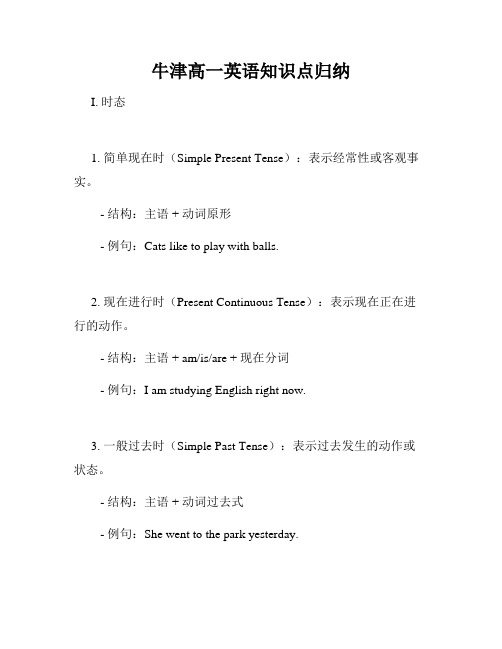
牛津高一英语知识点归纳I. 时态1. 简单现在时(Simple Present Tense):表示经常性或客观事实。
- 结构:主语 + 动词原形- 例句:Cats like to play with balls.2. 现在进行时(Present Continuous Tense):表示现在正在进行的动作。
- 结构:主语 + am/is/are + 现在分词- 例句:I am studying English right now.3. 一般过去时(Simple Past Tense):表示过去发生的动作或状态。
- 结构:主语 + 动词过去式- 例句:She went to the park yesterday.4. 过去进行时(Past Continuous Tense):表示过去某个时间正在进行的动作。
- 结构:主语 + was/were + 现在分词- 例句:We were playing basketball at 5 p.m. yesterday.5. 将来时态(Future Tenses):表示将来将要发生的动作。
- 一般将来时(Simple Future Tense):结构:主语 + will + 动词原形例句:They will arrive tomorrow.- 进行时态(Future Continuous Tense):结构:主语 + will be + 现在分词例句:I will be studying when you come.II. 被动语态1. 一般现在时的被动语态(Simple Present Passive):表示主语是动作的接受者。
- 结构:主语 + am/is/are + 被动语态- 例句:The book is read by many people.2. 一般过去式的被动语态(Simple Past Passive):表示过去某个动作的接受者。
- 结构:主语 + was/were + 被动语态- 例句:The car was driven by my father yesterday.3. 情态动词的被动语态(Modal Verbs in Passive):表示对于某种动作的可能性或能力。
牛津译林版高一英语必修一核心考点期末考试复习提纲
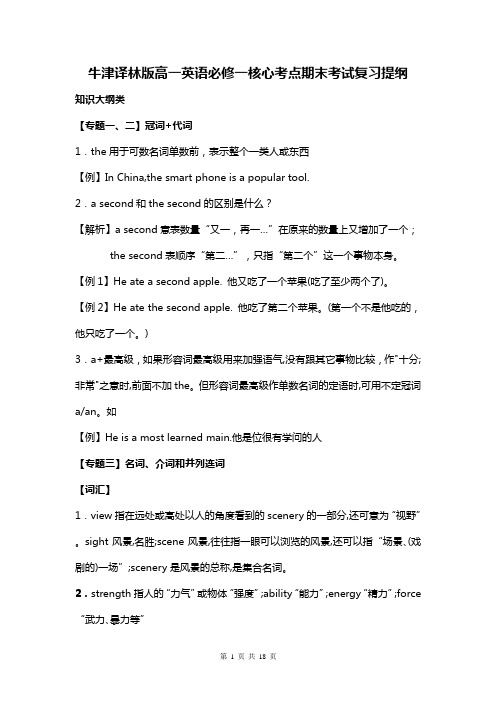
牛津译林版高一英语必修一核心考点期末考试复习提纲知识大纲类【专题一、二】冠词+代词1.the用于可数名词单数前,表示整个一类人或东西【例】In China,the smart phone is a popular tool.2.a second和the second的区别是什么?【解析】a second意表数量“又一,再一…”在原来的数量上又增加了一个;the second表顺序“第二…”,只指“第二个”这一个事物本身。
【例1】He ate a second apple. 他又吃了一个苹果(吃了至少两个了)。
【例2】He ate the second apple. 他吃了第二个苹果。
(第一个不是他吃的,他只吃了一个。
)3.a+最高级,如果形容词最高级用来加强语气,没有跟其它事物比较,作"十分;非常"之意时,前面不加the。
但形容词最高级作单数名词的定语时,可用不定冠词a/an。
如【例】He is a most learned main.他是位很有学问的人【专题三】名词、介词和并列连词【词汇】1.view指在远处或高处以人的角度看到的scenery的一部分,还可意为“视野”。sight风景,名胜;scene风景,往往指一眼可以浏览的风景,还可以指“场景、(戏剧的)一场”;scenery是风景的总称,是集合名词。2.strength指人的“力气”或物体“强度”;ability“能力”;energy“精力”;force “武力、暴力等”3.atmosphere气氛;state状态;situation处境;phenomenon现象4.against 反对,违反;靠;倚;防备【短语】1.ahead of schedule/ahead of time/in advice“提前”;on schedule按时2.anyhow 总之;无论如何;不管怎样;somehow不知怎么地;莫名其妙地3.at the height of my career“在我事业的高峰期”4.be at one's best 处于最佳状态5.be for支持, 赞成;be against反对;不同意6.be home to=be the home of是……的所在地7.be a mess/ be in a mess意为“很凌乱,一团糟”8.be similar to sb. in sth. 和某人在某方面相似9.by means of通过……手段;by no means 绝不;by all means一定,务必10.by nature天生地;by chance=by accident偶然,意外地;by far至今11.due to sb. / sth.意为“由某人/某事引起的”;be due to 应该12.equal to和……相等,等于……;similar to和……相似;13.in control of控制……;in the control of在……的控制之中。14.in exchange交换;in brief总之;in cash用现金支付15.in return 作为报答;in turn 轮流,依次,反过来;in particular尤其,特别16.in terms of谈及,就……而言,在……方面; in place of代替; 17.inform sb…of…告知某人…;warn sb. of…警告某人…;accuse sb.…of…指控某人…18.more…than…“与其说…倒不如说…”【专题四】形容词和副词形容词考查在单项填空题中一般涉及两类题型:(1)单纯的形容词在某个语段中的意义用法,所涉及的四个形容词从语意方面具有随机性,相互之间没有任何相近或相似之处,只考查哪个词适合所在的语言片段,大部分测试题采用类似的测试路线,旨在了解学生的词汇量水平。
高中英语 牛津译林版必修第一册Unit1知识梳理
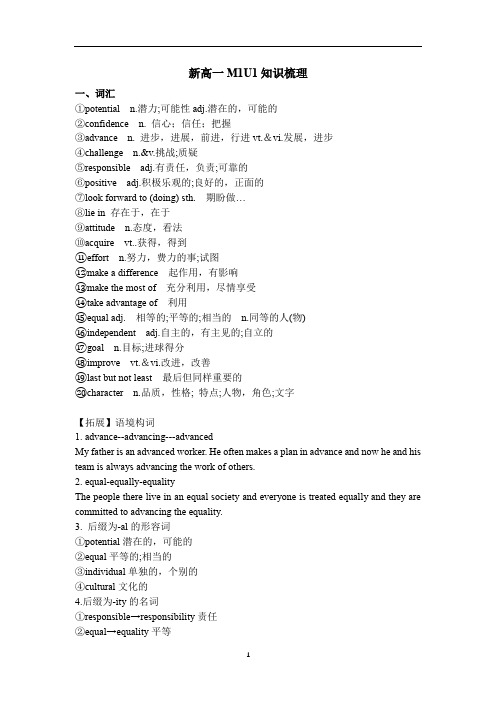
新高一M1U1知识梳理一、词汇①potential n.潜力;可能性adj.潜在的,可能的②confidence n. 信心;信任;把握③advance n. 进步,进展,前进,行进vt.&vi.发展,进步④challenge n.&v.挑战;质疑⑤responsible adj.有责任,负责;可靠的⑥positive adj.积极乐观的;良好的,正面的⑦look forward to (doing) sth. 期盼做…⑧lie in 存在于,在于⑨attitude n.态度,看法⑩acquire vt..获得,得到⑪effort n.努力,费力的事;试图⑫make a difference 起作用,有影响⑬make the most of 充分利用,尽情享受⑭take advantage of 利用⑮equal adj. 相等的;平等的;相当的n.同等的人(物)⑯independent adj.自主的,有主见的;自立的⑰goal n.目标;进球得分⑱improve vt.&vi.改进,改善⑲last but not least 最后但同样重要的⑳character n.品质,性格; 特点;人物,角色;文字【拓展】语境构词1. advance--advancing---advancedMy father is an advanced worker. He often makes a plan in advance and now he and his team is always advancing the work of others.2. equal-equally-equalityThe people there live in an equal society and everyone is treated equally and they are committed to advancing the equality.3. 后缀为-al的形容词①potential潜在的,可能的②equal平等的;相当的③individual单独的,个别的④cultural文化的4.后缀为-ity的名词①responsible→responsibility责任②equal→equality平等③positive→positivity积极性④active→activity活动二、词汇用法1. What is the best way for you to improve your reading skills?(教材P3)对你来说,改善你的阅读能力的最好方法是什么?1)improve vi.&vt. 改进;改善;变得更好improvement n.改进;改善2)体会improve的意义和用法e.g. His quality of life has improved dramatically since the operation.手术后他的生活质量大大改善了。
牛津译林版高中英语必修Book 3 Unit 2 Natural disasters知识点清单
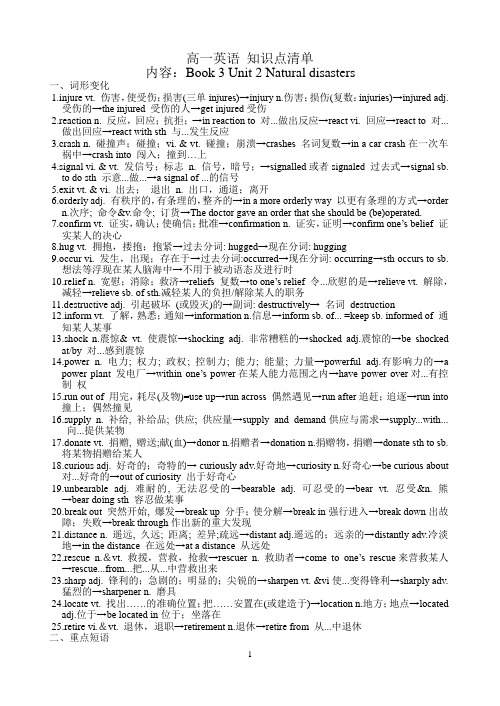
高一英语知识点清单内容:Book 3 Unit 2 Natural disasters一、词形变化1.injure vt. 伤害,使受伤;损害(三单injures)→injury n.伤害;损伤(复数:injuries)→injured adj.受伤的→the injured 受伤的人→get injured受伤2.reaction n. 反应,回应;抗拒;→in reaction to 对...做出反应→react vi. 回应→react to 对...做出回应→react with sth 与...发生反应3.crash n. 碰撞声;碰撞;vi. & vt. 碰撞;崩溃→crashes 名词复数→in a car crash在一次车祸中→crash into 闯入;撞到…上4.signal vi. & vt. 发信号;标志n. 信号,暗号;→signalled或者signaled 过去式→signal sb.to do sth 示意...做...→a signal of ...的信号5.exit vt. & vi. 出去;退出n. 出口,通道;离开6.orderly adj. 有秩序的,有条理的,整齐的→in a more orderly way 以更有条理的方式→ordern.次序; 命令&v.命令; 订货→The doctor gave an order that she should be (be)operated.7.confirm vt. 证实,确认;使确信;批准→confirmation n. 证实,证明→confirm one’s belief 证实某人的决心8.hug vt. 拥抱,搂抱;抱紧→过去分词: hugge d→现在分词: hugging9.occur vi. 发生,出现;存在于→过去分词:occurred→现在分词: occurring→sth occurs to sb.想法等浮现在某人脑海中→不用于被动语态及进行时10.relief n. 宽慰;消除;救济→reliefs 复数→to one’s relief 令...欣慰的是→relieve vt. 解除,减轻→relieve sb. of sth.减轻某人的负担/解除某人的职务11.destructive adj. 引起破坏(或毁灭)的→副词: destructively→名词destructionrm vt. 了解,熟悉;通知→information n.信息→inform sb. of... =keep sb. informed of 通知某人某事13.shock n.震惊& vt. 使震惊→shocking adj. 非常糟糕的→shocked adj.震惊的→be shockedat/by 对...感到震惊14.power n. 电力; 权力; 政权; 控制力; 能力; 能量; 力量→powerful adj.有影响力的→apower plant 发电厂→within one’s power在某人能力范围之内→have power over对...有控制权15.run out of 用完,耗尽(及物)=use up→run across 偶然遇见→run after追赶;追逐→run into撞上;偶然撞见16.supply n. 补给, 补给品; 供应; 供应量→supply and demand供应与需求→supply...with...向...提供某物17.donate vt. 捐赠, 赠送;献(血)→donor n.捐赠者→donation n.捐赠物,捐赠→donate sth to sb.将某物捐赠给某人18.curious adj. 好奇的;奇特的→ curiously adv.好奇地→curiosity n.好奇心→be curious about对...好奇的→out of curiosity 出于好奇心19.unbearable adj. 难耐的, 无法忍受的→bearable adj. 可忍受的→bear vt. 忍受&n. 熊→bear doing sth 容忍做某事20.break out 突然开始, 爆发→break up 分手;使分解→break in强行进入→break down出故障;失败→break through作出新的重大发现21.distance n. 遥远, 久远; 距离; 差异;疏远→distant adj.遥远的;远亲的→distantly adv.冷淡地→in the distance 在远处→at a distance 从远处22.rescue n.&vt. 救援,营救,抢救→rescuer n. 救助者→come to one’s rescue来营救某人→rescue...from...把...从...中营救出来23.sharp adj. 锋利的;急剧的;明显的;尖锐的→sharpen vt. &vi使...变得锋利→sharply adv.猛烈的→sharpener n. 磨具24.locate vt. 找出……的准确位置;把……安置在(或建造于)→location n.地方;地点→locatedadj.位于→be located in位于;坐落在25.retire vi.&vt. 退休,退职→retirement n.退休→retir e from 从...中退休二、重点短语1.at large 整个,全部2.roll call 点名3.safe and sound 安然无恙的4.occur to被想到,浮现在脑中5.keep one's head(在困境中)保持冷静6.run out of 用完,耗尽7.take the form of呈现...的形状;采取...的形式8.break out突然开始,爆发9.far and wide 到处,各处10.natural disasters 自然灾难11.kind of 稍微,有几分,有点儿12. a loving mother 慈母,慈爱的母亲13. a butcher in cold blood 冷血屠夫14.(be)caught in 陷于,淋雨15.an excerpt from a novel 小说节选16. a famous volcanic eruption 出名的火山喷发17.make an information folder 制作信息文件夹18.escape an earthquake 躲避地震19.suffer slight injuries 轻微受伤20.head teacher 班主任;校长21.hold on to 保住,守住;保存,保留;坚持22.at the same time 与此同时23.in case 以防,万一24.loud crashes of glass breaking 玻璃破碎的巨大撞击声25.remain still 别动,保持不动26.the moment 一……就27.make one’s escape 逃跑28.signal to her students to exit theclassroom 示意学生们离开教室29.in an orderly line 整齐地排成一行,有序的一行/一队30.go down the stairs 下楼,下楼梯31.rush to 奔向,冲向,急急前往32. a series of 一系列33.leave thousands dead 造成数千人死亡34.survive the disaster 从灾难中幸存下来35. a 10-year-old girl 十岁的女孩36.on the sandy beach 在沙滩上37.on the top of 在……上面,在……顶上38.signs of an approaching tsunami 海啸逼近的迹象39.warn sb of sth 警告某人某事40. a safety officer 安全员41.to one’s great relief 令某人极为欣慰的是42.the coming danger 即将到来的危险43.clear...of...清除掉……的……44.crash into the coast 坠入海岸45.at a primary school在小学46. a destructive storm一场毁灭性的风暴47.neighbouring countries 邻国48.cause serious damage 造成严重损害49.get prepared for 为……做准备50.in order to 为了51.protect...from...保护……免受……52.make the difference between life anddeath 起着生死攸关的作用53.tie down large outdoor objects 系紧大型室外物体54.blow away 吹走,刮走;炸飞,干掉;使印象深刻rm sb./oneself of 通知某人/自己……56.go on 进行,发生;继续;流逝,过去;接着做;凭…作出判断;开始运转,开启57.pay attention to 注意58.news updates 新闻更新59.in the face of 面对60.drinking water 饮用水61.water the flowers 浇花62.master these words 掌握这些单词e sensory information 使用感官信息64.put the reader in the action 让读者参与进来65.descriptive details 描述性细节66.allow sb to do sth 允许某人做某事67.transport...into the scene 把……带进场景68.attend a conference 参加会议69.one of the cities to be hit 被袭击的城市之一70.turn on the TV 打开电视机71.on one’s way 在路上;快要到来72. a bit of a shock 有点震惊73.much too dangerous 太危险,非常危险74.the power failure 电力故障,停电75.be afraid of 害怕……76.only to see huge trees lying across thestreet 只看到大树横躺在街上e to help 来帮忙78.donate food and clothes to charities 给慈善机构捐食物衣服79.in this case 在这种情况下80.match... with... 把……和……搭配起来81.the local people 当地人82.arrive at the airport 到达机场83.learn some safety tips 学习一些安全提示84.attend a staff meeting 参加员工会议85.describe ...in great detail 详细描述……86.raise funds 筹集基金87.go through 经历,经受;翻阅,翻找;通读;彻查;被通过,被批准88.people from other neighbourhoods 其他社区的人89.provide sb with sth 向某人提供……90.sleeping bags 睡袋91.give sb advice 给某人建议92.flood safety tips洪水安全提示93.wash away 冲垮,冲走94.the upper levels of ……的上层95.watch out for 当心,密切注意;戒备,提防96.stay away from 远离97.keywords=key words 关键词98.in the living room 在起居室,在客厅里99.look through 逐一查看,浏览,翻阅;穿过……看100.the endless rain outside 外面没完没了的雨101.rain non-stop 雨不停地下102.a storm this bad 这么严重的风暴/暴雨103.on the roof 在屋顶上104.a weather report天气预报,天气报告105.on the radio 广播中,通过广播106.disaster supplies 救灾物资107.right away 立刻,马上108.be curious to do sth 好奇地……109.move the dinner table against the door 把餐桌顶在门上110.force the door open 用力把门打开,把门迫开/撞开111.ask for clarification 要求澄清112.transitional words or sentences 过渡词或句113.make connections with 与……联系起来114.in terms of 就……而言115.reveal a character’s personality 揭露一个人物的性格116.a talented British writer 有才华的英国作家117.leave one’s mark on 在……留下印记,产生深远的影响118.classic novel 经典小说119.an international tourist destination 国际旅游胜地120.a typical Roman city 典型的罗马城市121.in the energy and skill of its people 在其人民的活力和技艺里122.trading ships 商船123.golden pleasure boats 金色游船124.in the glassy water of the port 在港口的光滑如镜的水中125.move in all directions 向四面八方移动126.above all 尤其,首先127.roll away 滚动离开,翻滚离开,滚滚而去;滚开128.with unspeakable fear 带着无法形容的恐惧129.of a pale and dying red 一种苍白的,快要死的红色130.at that moment 在那一刻131.in the distance 在远处132.the crash of falling roofs 屋顶坍塌的巨响133.a moment later 一会儿之后134.throw out 扔掉,丢掉;错过,浪费;不受理,不立案;撵走,开除135.a shower of ashes 阵雨似的灰烬136.many a noisy crash 许多嘈杂的撞击声137.in the stormy sea 在狂风暴雨中138.push against the other 推挤对方139.be separated from 与……分离140.no hope of 没有……的希望141.resting place 休息处,安息处,坟墓142.as if 好像143.the remains of ……的剩余物/遗物/遗骸144.burn bright and short 烧得灿烂而短暂145.a sense of fear and confusion 恐惧和困惑感146.be aware of 意识到,明白147.search and rescue dogs 搜救犬148.life detector 生命探测器/探测仪149.search and rescue robots 搜救机器人150.unmanned aircraft 无人驾驶飞机,无人机151.advantages and disadvantages 优缺点,优势和劣势,利与弊152.rescue efforts on land 陆上救援153.sharp sense of smell 敏锐的嗅觉154.locate survivors 定位到幸存者,找到幸存者155.raise a type of dog 养一种狗156.a destructive earthquake 毁灭性地震157.work alongside members of the China International Search and Rescue Team与中国国际搜救队一起工作158.the best-known novel最著名的小说159.leave one's drought-hit home 离开干旱袭击的家园160.in search of 寻找,搜寻161.the struggle for survival 为生存而做的斗争162.bring about 导致,引起,带来163.extreme weather events 极端天气事件三、重点句子1.Only 5 students suffered slight injuries, despite the current figures of 7 killed and over 200 injured in the disaster area at large. 尽管目前整个灾区的伤亡数字是7 人死亡,200 多人受伤,但(在这所学校)只有5 名学生受了轻伤。
牛津译林版高一英语单元词汇归纳汇总

牛津译林版高一英语单元词汇归纳汇总Book1Uint11experience n.[U]经验;[C] 经历;vt.体验,经历[应试指导](1)注意可数与不可数时意思的区别(2)人物介绍类写作高频词汇1have/gain much experience in/at doing...有/获得许多做……的经验learn by/from experience 从经验中学习2be experienced in/at doing...在……方面有经验2respect n.&vt.尊重,敬重;尊敬[应试指导]人物类写作高频词汇1have/show respect for=pay respect to尊敬;尊重give/send respects to sb.向某人问候in some respects在某些方面out of respect出于尊重in respect of=with respect to关于,就……来说2respect sb.forsth.因某事尊重某人3respectable adj.值得尊敬的;不错的;体面的4respectful adj.尊敬他人的,恭敬的,有礼貌的3devote vt.献身;致力于;专心[应试指导]devote的词形变化及其相关短语的考查(1)devote oneself/one’s energy/time/attention to sth./doing sth.奉献于……;献身于……devote sth.to sth.把……用于……(2)devoted adj.献身的;忠诚的be devoted to深爱,致力于(3)devotion n.关爱,关照;奉献,忠诚4exchange n.交换;互换giving and receiving;交流communication;兑换;v.调换;交换;交流communicate;兑换change[应试指导]写作高频词汇:(1)交换生exchange student(2)交流思想exchange thoughts/ideas1exchange A for B用A换Bexchange sth.with sb.与某人交换某物2in exchange for变换;交换in exchange作为交换)5inform vt.通知,告知[应试指导](1)过去分词作宾补(2)应用类写作高频词汇inform sb.of/about sth.通知某人某事inform sb.that/how/when通知/告知某人……keep rmed of...随时告知某人……be informed of听说;接到……的通知6charge vt.使承担责任,收费;控告;充电;n.负责,掌管;收费;指责[应试指导]熟词新义的考查1charge sb.with doing sth.=accuse sb.of doing sth.指控某人犯……罪charge sb.some money for sth.因某事物收某人多少钱2in charge of掌管,负责,管理表状态take charge of掌管表动作in the charge of sb.=in one’s charge 由某人负责free of charge免费的7preparation n.准备,筹备1in preparation在准备中make preparations for为……做准备2prepare v.准备;使……准备好prepare for sth.为某事做准备prepare sb.sth.=prepare sth.for sb.为某人准备……3prepared adj.做好准备的be/get prepared for为……做好准备be prepared to do sth.乐意并能够做某事8look back on回忆,回顾[应试指导]look相关短语的语境词义辨析look down on/upon看不起look forward to盼望look into向……里面看;调查look through浏览;仔细查看;审核look up向上看;查阅look up to尊敬,敬仰9become used to变得习惯于[应试指导]写作高频词汇be used to doing sth.习惯于做某事used to do sth.过去常常做某事be used to do sth.被用来做某事10average adj.平均的;普通的normal;典型的typical;n.平均数;平均水平;v.平均为;计算出……的平均数be equal to...as an average11struggle n.难事;斗争;努力;vi.奋斗,努力;挣扎struggle with/agains struggle for struggle to do sth.努力做某事12make use of利用make the most/best of/make full/good use of充分利用13more than多于;不仅仅;不只是14Going to a British high school for one year was a very enjoyable and exciting experience for me.去一所英国高中读书一年对我来说是一次非常愉快和兴奋的经历。
高一下学期英语牛津译林版必修第册 Book3 Unit3 The world online知识点清单

2021年春学期高一英语知识点清单内容:Book3 Unit3 The world online一、词形变化1.access n.机会,权利;入径,通道vt.到达,进入,使用→accessible adj.易接近的,可进入的2.major adj.主要的,较多的→ majority n.大部分,大多数;多数票→反义词:minority 3.deliver vt.递送,传送;发表,宣布;交出→delivery n.递送4.establish vt.建立(关系或联系);设立;确立;使得到认可;查实,确定→establishment n.确定,制定;建立5.instant adj.立即的,立刻的;方便的n.瞬间,片刻;某一时刻→instantly adv.立即地6.aware adj.知道,意识到;察觉到,发觉;有……意识的→unaware adj.无意识的,未觉察的→awareness n.意识,明白,知道7.entertain vt.娱乐,招待→ entertainment n.娱乐活动;招待,娱乐→adj.entertaining 使人愉快的,有趣的,娱乐的8.addict n.对……入迷的人;瘾君子→addicted adj.入了迷的,上了瘾的→n. addiction 瘾;入迷,嗜好9.appreciate vt.欣赏,赏识;感谢→appreciation n.欣赏;感谢二、重点短语1.take off 突然大受欢迎,迅速流行2.to a certain exten t在一定程度上3.at one's fingertips掌握(信息),熟悉、精通(知识等),了如指掌4.bring up使显示在计算机屏幕上,调出;提出5.above all else最重要的是,尤其是6.belong to属于,归…所有7.set up创建,建立8.be glued to sth全神贯注看着某物,离某物很近9.shoot past 飞驰而过10.knock sb off one's feet撞倒某人,使某人双脚离地11.be lost in 全神贯注,沉浸于12.cut back on 减少,削减13.cross barriers and connect cultures 跨越障碍,连接文化14.a blog post 一篇博客(帖子)15.hold a debate 举行辩论16.important milestones in the development of the Internet 网络发展中重要的里程碑17.send an email 发送电子邮件19.separate...from...把……和……分离开来20.avoid wasted trips for coffee 避免浪费时间去喝咖啡21.Chinese characters 汉字22.throughout the world 全世界23.a technological wonder 科技奇迹24.far-reaching changes 影响深远的变化25.all aspects of one’s lives 生活的方方面面26.on the Internet 在网上27.a world without frontiers 没有边界的世界28.a single shared community 单一共享社区29.enable sb to do sth 使某人能够做某事30.reach beyond one’s villages 越过村庄,走出村庄31.life-changing advantages 改变生活的好处32.to a certain extent 在某种程度上33.travel packages 旅游套餐itary affairs 军事事务35.learning resources 学习资源36.a search engine 搜索引擎37.no wonder 难怪38.the majority of 大多数39.turn to... for information 向……获取信息40.all sorts of 各种各样的41.electronic commerce 电子商务42.search shop after shop 一个店一个店的寻找pare styles and prices 比较式样和价格44.go on holiday 去度假45.make all one’s travel arrangements 安排好旅行46.establish and maintain social tie 建立并维持社会关系47.physical distance 身体距离,物理距离48.get in the way 挡道,妨碍49.keep in contact with 与……保持联系50.long-lost friends 久违的朋友51.as with 如同,和……一样,就……而言52.be aware of 意识到53.a place of discovery, wonder and inspiration 一个有发现、有奇迹和有灵感的地方54.supporting details 支持细节55.have access to 有权使用,接近,可以利用56.gather information 收集信息57.order a taxi 叫出租车58.keep in contact with 与……保持联系59.in various ways 以各种方式60.bring sb great convenience 给某人带来极大的方便61.raise all sorts of questions 提各种问题62.surf the Internet 上网63.in the digital world 在数字世界puter files 电脑文件65.have the right to say no 有权利拒绝66.cut off contact 切断联系67.leave a comment on an update 对更新留言68. (be) likely to 很可能……69.various styles of dancing 各种舞蹈风格70.inspiring stories 鼓舞人心的故事71.on a regular basis 定期地,经常地72.achieve such success 取得这样的成功73.so as to 以便74.satisfy different uses' needs 满足不同用户的需要75.do research 进行研究76.jump for joy 高兴得跳起来77.get...doing 开始做,让……开始……78.the picture bank 图片库79.give a brief introduction to 对……作简要介绍e onto the market 上市81.in general 总的来说,大体上,总体上82.the early/ late 1980s 20世纪80年代初/末83.instant messaging 即时通信84.travel booking 旅游预订85. bar charts 条形图,柱状图pie charts 饼状图line charts 线状图86.remain / stay the same / unchanged 保持不变87.in a formal style 用正式的风格e to a conclusion 得出结论89.(be)based on facts and figures 基于事实和数字90.clarify the recent changes 澄清最近的变化91.predict the future 预测未来92.a smartphone addict 手机迷,手机上瘾者93.reach for 伸手去取94.a dead battery 没电的电池95.feel stressed 感到有压力96.take up 开始从事,喜欢上,开始干;占用,花费;占领;继续,把…接着进行下去97.quit the habit 戒掉这个习惯98.make a change 做出改变,进行变革99.at that very moment 就在那一刻100.make up one's mind 下决心101.be used to doing sth 习惯于做某事102.social media updates 社交媒体更新103.every few minutes 每隔几分钟104.something of value 有价值的东西105.slow down 减速,慢下来106.stretch out 伸展;平躺;伸出,伸开107.feel disconnected from 与……不联系,与……失去联系108.pick up 拿起,拾起,站起(或爬起);接载,取走;获得,学会;得(病);接收到;发现,找到,识别;好转;恢复;加速109.best of all 最好的是110.with one's own eyes 用自己的眼睛111.wide-ranging conversation 广泛的谈话112.enjoy each other's company 享受彼此的陪伴113.up to date 现代的,最新的,时髦的,新式的114.a great appreciation for life 对生活的极大感激115.escape from the modern world 逃离现代社会116.take advantage of 利用117.put down 放下;写下;镇压118.argue against 为反对…而辩,反驳119.on the contrary 相反120.the“for”side 支持方the “against” side 反对方121.the other way round 反过来说,相反122.in emergencies 在紧急情况下123,seek help 寻求帮助124.in trouble 在麻烦中,有麻烦125.in addition 另外126.like Pandora's box 就像潘多拉的盒子127.cause sb to do sth 促使某人做某事128.break into 强行进入,闯入;突然开始做,成功打入,顺利进入129.cover different topics 涵盖不同主题130.explore the most basic principles 探索最基本的原则三、重点句子1.In the time it takes to find one book in the library,we can use a search engine to bring up millionsof results.在图书馆找一本书所花的时间里,我们可以用搜索引擎找到数百万条的结果。
牛津译林版高一英语上册知识点:Unit 1 School life

牛津译林版高一英语上册知识点:U n i t1S c h o o l l i f e (一)词汇attendearnrespectachievegradesubjectliteratureaverageonaverageanaverageofcookingextraSpanishetc.missdessertvt.参加,出席n.获得v.尊敬,敬重v.取得,完成n.等级,成绩n.科目n.文学adj.普通的;平均的n.平均数;普通n.烹饪adj.另外的,额外的n.西班牙语adj.西班牙的,西班牙人的,西班牙语的等等v.想念n.餐后甜点dessert,desert/e/dessert表示甜点,而desert表示沙漠。
但是desert也可以发/i/,这时它是作为动词,意思是抛弃,离弃。
例:荒岛adesertedisland experiencevt.经历,体验辨析experience和experimentexperience表示经验,经历,而experiment表示实验。
注意两个单词拼法上的区别。
articlevt.文章immediatelyvi立刻,马上(二)课文重难点1.meanv.意味Whatdoyoumean1)meanthat+宾语从句我是说你不需要今天就完成。
Imeanyouneedn’tfinishittoday.2)meandoing Fallingintotheriveronsuchacolddaymeanslosingyourlife.学好英语意味着花大量的时间。
LearningEnglishmeansspendingalottime.3)meantodo计划=plantodoIdidn’tmeantohurtyou.我们本打算给你一个惊喜的。
Wemeantogiveyouasurprise.联想1:meaningWhat’sthemeaningofthiswordDoyouknow2.attend,takepartin,joi n和joininattend,takepartin,join和joinin都表示“参加”的意思。
高一英语必修一知识点总结 译林
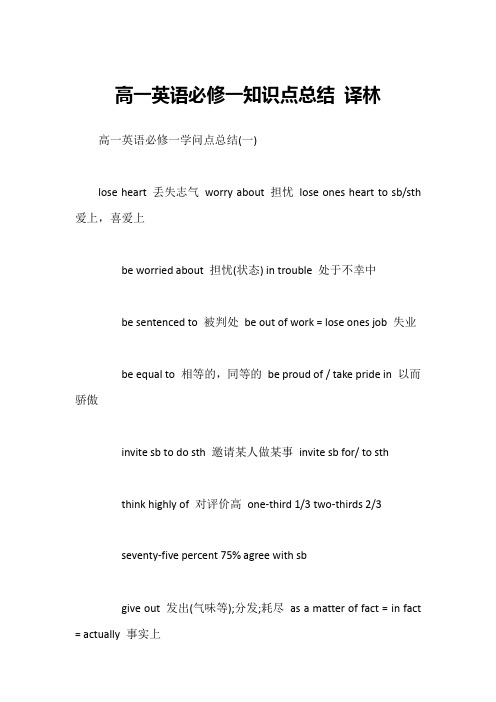
高一英语必修一知识点总结译林高一英语必修一学问点总结(一)lose heart 丢失志气worry about 担忧lose ones heart to sb/sth 爱上,喜爱上be worried about 担忧(状态) in trouble 处于不幸中be sentenced to 被判处be out of work = lose ones job 失业be equal to 相等的,同等的be proud of / take pride in 以而骄傲invite sb to do sth 邀请某人做某事invite sb for/ to sththink highly of 对评价高one-third 1/3 two-thirds 2/3seventy-five percent 75% agree with sbgive out 发出(气味等);分发;耗尽as a matter of fact = in fact = actually 事实上blow up 充气爆炸beg for 乞讨set up 建立,创立;设置,竖起send up 放射,使上涨set about 着手做某事(set about doing sth)go up 上升,增长;被兴建set off 启程,动身set up 设立,建立;设置,竖起set out 陈设,摆出;起先(set out to do sth) stop sb (from) doing sthbe active in = take an active part in 踊跃参加,在活泼keep sb from doing sth阻挡某人做某事die for 为而死die from 死于(外因)prevent sb (from) doing sthdie of 死于(内因如:饥饿,寒冷,疾病等)be proud of / take pride in 以而骄傲invite sb to do sth 邀请某人做某事invite sb for/ to sth agree with sbthink highly of 对评价高one-third 1/3two-thirds 2/3 seventy-five percent 75% give out 发出(气味等);分发;耗尽put sb in prison= throw sb into prison= send sb to prison 把投入监狱advise sb to do sth 建议某人做某事advice 不行数a piece of adviceadvise doing sth fight for 为争取而斗争advise sb on sthfight against 为反对而斗争advise that (should)+ v原fight with 同并肩作战/ 同斗争have problems/ difficulty/ trouble with sthwork out 算出have a go= have a try break the law 违反法律have problems/ difficulty/ trouble (in) doing sth be willing to do sth 乐于做某事realize ones dream of 实现的幻想answer violence with violence 以暴制暴come to power 当权,上台social activities 社会活动equal (adj)---equally (adv)---equality (n) violence (n)------violent (adj)cruelty (n)---cruel (adj)---cruelly (adv) educated (adj)------education (n)willing----unwilling 不情愿的active----inactive 不活泼的高一英语必修一学问点总结(二)1.Only then did we decide to answer violence with violence.only 放在句首且后接状语时(作状语:副词;介词短语;状语从句),要运用局部倒装------才用一般疑问句语序。
- 1、下载文档前请自行甄别文档内容的完整性,平台不提供额外的编辑、内容补充、找答案等附加服务。
- 2、"仅部分预览"的文档,不可在线预览部分如存在完整性等问题,可反馈申请退款(可完整预览的文档不适用该条件!)。
- 3、如文档侵犯您的权益,请联系客服反馈,我们会尽快为您处理(人工客服工作时间:9:00-18:30)。
高一英语重点高频次知识点总结重点句型1.“So + be/have/助动词/情态动词+主词”的结构。
此结构中的语序是倒装的,“So”代替上句中的某个成分。
如果上面一句是否定“Neither/Nor+be/have/助动词/情态动词+主语”的结构。
例如He’s tired,and so am I.(=I’ m also tired.)Y ou can swim,and so can I.(=I can also swim.)She has had supper,and so can I.(=I’ve had lunch,t o o.)Tom speaks English,and so does his sister.(=His sister speaks English,t o o.)A: I went to the park yesterday.B: So did I.(=I also went to the park yesterday.)2.“So +主语+be/have/助动词/情态动词”结构中的主谓是正常语序,s o相当于indeed,certainly,表示说话人对前面或对方所说情况的肯定、赞同或证实,语气较强,意思是“确实如此”。
例如A:It was cold yesterday.昨天很冷。
B:So it was.的确如此。
(=Yes,it was.)A:You seem to like sports.B:So I do.(=Yes,I do.)A:It will be fine tomorrow.B:So it will.(=Yes ,it will.)3.“主语+do/does/did + so”结构指的是按上句的要求做了。
此句型中do so代替上文中要求做的事,以免重复。
My Chinese teacher told me to hand in my composition on time and Idid so.(=I handed inmy composition on time.)语文老师叫我按时交作文, 我照办了。
4.So it is with…或It is the same with…句型表示“……(的情况)也是如此。
”当前面的句子中有几种不同形式的谓语时,要表示相同情况,必须使用本句型,不能使用so 引起的倒装句。
She doesn’t play the piano, but she likes singing. So it is with my sister.5、There you are.行了,好。
这是一句表示一种事情告一段落或有了最终结果的用语。
如:There you are! Then let's have some coffee.除此之外,还可以表示“瞧,对吧(果然如此)”的语气。
例如:There you are! I knew we should find it at last.对吧!我就知道我们最终能找到的。
6、have some difficulty (in) doing sth. 干某事有困难;接名词时,常用句型:have some difficulty with sth.①Do you have any difficulty (in) understanding English?你理解英语口语有困难吗?②She said she had some difficulty with pronunciation.她说她在发音方面有困难。
7、have a good knowledge of sth.“掌握……”,“对……有某种程度的了解”①He has a good knowledge of London.他对伦敦有所了解。
②A good knowledge of languages is always useful.8、Tree after tree went own, cut down by the water, which must have been three metres deep.一棵又一棵的树被水冲倒、冲断。
那水肯定有三米深。
“must have + 过去分词”表示对已发生事情的猜测。
在英语中,must,m a y三个情态动词可用来表示对事情的猜测。
Must意为“肯定”,语气很有把握;意为“可能”、“也许”,语气把握性不大。
两者常用在肯定句中。
Can意肯定”、“也许”,常用在否定句或疑问句中。
Must,m a y,can三者用于表示猜测时,其后面可跟三种不同的动词形式:1)跟动词原形表示对现在事情的猜测;2)跟be doing表示对正在发生事情的猜测;3)跟have done表示对已经发生的事情的猜测。
例如:Helen is Lucy’s good friend. She must know Lucy’s e-mail.海伦是露茜的好朋友。
她肯定知道露茜的电子邮件。
We can hear loud voices in the meeting room. They must be quarrelling.我们可以听到会议室很吵。
他们肯定在吵架。
I met Jeff at the gate a moment ago. He can’t have gone to Australia.我刚才还在大门口见过杰夫。
他不可能去了澳大利亚。
9、Wei Bin took out some peanuts and it was fun to see the monkey eat from his hand.魏彬拿出一些花生。
看着猴子从他手上吃花生,很有趣。
fun “好玩,趣事”,不可数名词,前面不加不定冠词a。
You’re sure to have some fun at the party tonight.今天晚上你肯定会玩得很开心。
make fun of“取笑”,“嘲弄”。
People make fun of him only because he is wearing such a strange jacket.人们嘲笑他只是因为他穿了一件那么奇怪的衣服。
funny adj. “可笑的,滑稽的”。
He looks very funny in his father’s jacket.他穿着他父亲的衣服,看上去很滑稽。
10、Many people who saw the film were afraid to swim in the sea……许多看过这部电影的人都不敢在海里游。
afraid 用法说明:1)害怕人/ 物,如:be afraid of sb / sth2)不敢做某事,如:be afraid to do sth / of doing sthHe is afraid to go out / of going out alone at night.3)担心会发生某事, 如: be afraid of doing sth或be afraid + that clause He seldom stands on the river bank because he is afraid of falling into the river.He seldom stands on the river bank because he is afraid that he might fall into theriver.4)给人不愉快的信息或不赞同某人意见时, 用I’m afraid …, 如:I’m afraid I’ve got bad news for you.I’m afraid I can’t agree with you.11、It is polite to finish eating everything on your plate.把你盘子里所有东西吃完是有礼貌的。
这是一个动词不定式作主语的句型,其中to finish eating everything 是主语,it是形式主语。
12、I wish you all the best.我祝你万事如意.用w i s h来表示祝愿的结构是wish sb sth, 此外我们还可以用m a y来表示祝愿: May sb do sth如:May you succeed.13、Where there is a river, there is a city.有河流的地方就有城市。
Where在这里引导的是地点状语从句,相当于介词in/ at/ to + the place + where从句9定语从句),意思是“在……地方”。
例如:Where there is smoke, there is fire.无风不起浪;事出有因。
He lives where the climate is mild.他住在气候温暖的地方。
14、Strong, proud, and united, the people of St Petersburg are the modern heroes of Russia .圣彼得堡人民坚强不屈、充满自豪、团结一致,他们是俄罗斯当代的英雄。
Strong, proud, and united为前置定语,在这里相当于一个非限制性定语从句:The people of St Petersburg , who are strong, proud, and united, are the modern heroes of Russia .当主语比较短时,这类短语常常放在句首。
15. Congratulations!是一句祝贺用语,在使用时要用复数形式。
其他几个通常以复数形式出现表达特定含义的名词有:manners(礼貌):He is a little boy with good manners.这个小男孩很有礼貌。
regards (问候):Please send my regards to your parents.请代我问候你父母。
16. Every four years athletes from all over the world take part in the Olympic Games.没四年,世界各地的运动员们都要参加奥运会。
“every + 基数词+ 时间/ 距离单位”词表示“每多少时间/ 距离”。
如:every five days(每五天), every three hours(每三小时), every ten metres(每十公尺)类似表达形式还有:every fifth day, every third hour“每隔一天”的表达形式有:every second day, every two days, every other day.17、Modern cellphones are more than just phones—they are used as cameras and radios, and to send e-mail or surf the Internet.现代的手机不仅仅是电话机—它们也当坐照相机和收音机使用,还可以发送电子邮件和上网。
